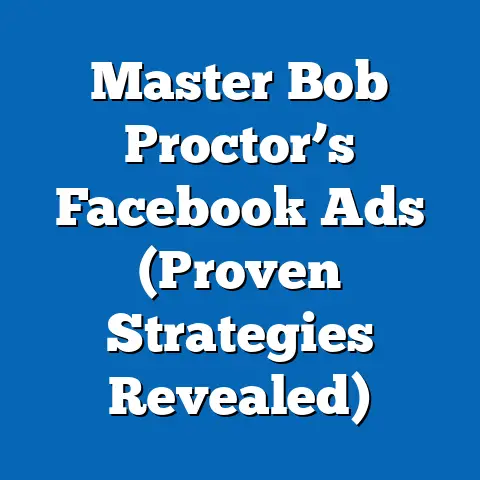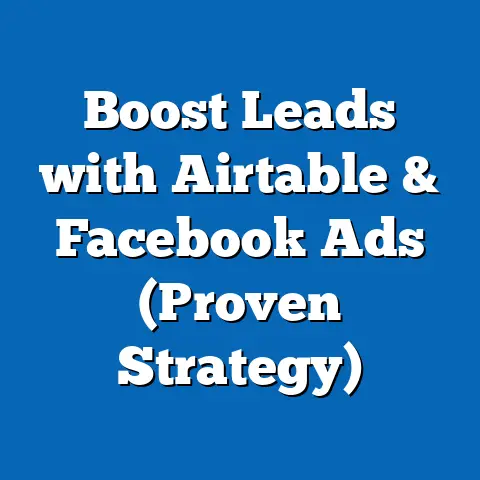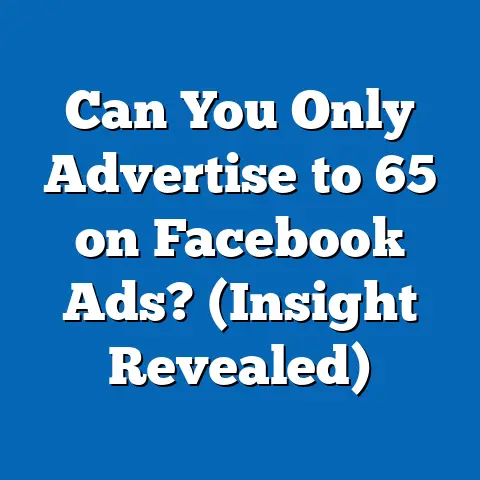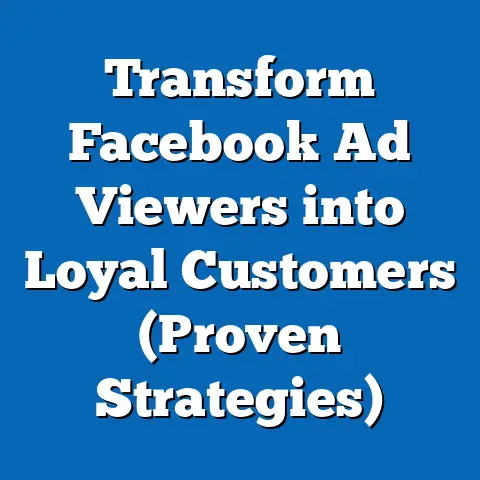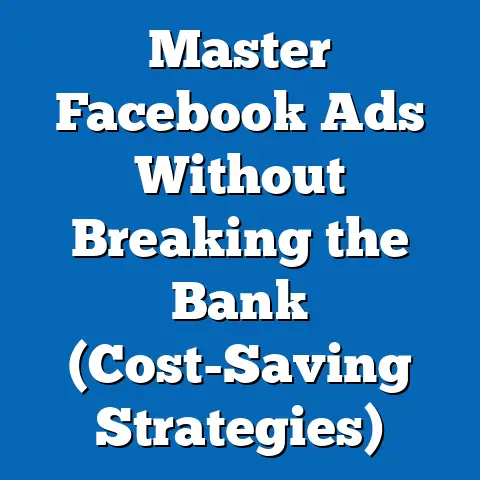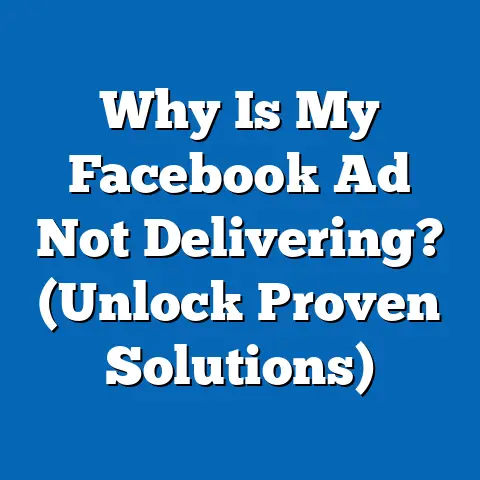Mastering Facebook Ads After County Targeting Changes (What You Need to Know)
Advertising has come a long way from town criers shouting the latest news to targeted ads popping up on our phones. Think about it: for centuries, reaching potential customers was a shot in the dark, a wide net cast hoping to catch a few interested parties. Then came the digital age, and platforms like Facebook promised a revolution: the ability to laser-focus your message on exactly the right people.
For local businesses, this was a game-changer. County targeting on Facebook became a powerful tool, allowing them to reach customers in their immediate area with personalized messages, promoting local events, special offers, and building a strong community presence. I remember when I first started working with a local bakery; county targeting was our bread and butter (pun intended!). We could specifically target people within a 5-mile radius who had expressed interest in baking or local food, leading to a significant increase in foot traffic and online orders.
But things have changed. Facebook’s recent shift in targeting options, particularly the limitations on county-level targeting, have left many advertisers feeling lost and uncertain. Concerns about privacy, data protection regulations, and the ever-evolving digital landscape have led to these changes, leaving businesses scrambling to adapt.
Understanding Facebook Ads
Before we dive into the specifics of targeting changes, let’s make sure we’re all on the same page about the fundamentals of Facebook Ads.
What are Facebook Ads?
Facebook Ads are paid advertisements that appear on Facebook, Instagram, Messenger, and the Audience Network. They allow businesses to reach a vast and diverse audience with tailored messages, driving traffic, generating leads, and increasing brand awareness. Essentially, they’re the digital equivalent of a billboard, newspaper ad, or TV commercial, but with the added benefit of precise targeting.
There’s a whole buffet of ad formats to choose from, each designed for a specific purpose:
- Carousel Ads: These allow you to showcase multiple images or videos in a single ad, perfect for displaying a range of products or highlighting different features of a service. Think of it as a mini-catalog within an ad.
- Video Ads: Engage your audience with captivating video content, whether it’s a product demo, a customer testimonial, or a brand story. Video ads are incredibly effective at grabbing attention and conveying complex information in an engaging way.
- Image Ads: The classic and straightforward ad format, ideal for showcasing a single product or service with a compelling visual. The key here is high-quality imagery and clear, concise messaging.
- Collection Ads: Designed for mobile shopping, these ads feature a main image or video accompanied by several product images below, allowing users to browse and purchase products directly from the ad.
- Lead Ads: These are fantastic for collecting leads directly on Facebook. Users can fill out a form with their contact information without ever leaving the platform, making it incredibly convenient for them and efficient for you.
The power of Facebook as an advertising platform lies in its sheer scale and engagement. With billions of active users worldwide, Facebook offers unparalleled reach. And it’s not just about the number of users; it’s about the depth of engagement. People spend a significant amount of time on Facebook, interacting with content, connecting with friends and family, and discovering new products and services.
The Role of Targeting in Facebook Ads
Targeting is the cornerstone of effective Facebook advertising. It’s the process of defining your ideal audience based on a variety of factors, including demographics, interests, behaviors, and location. Think of it as aiming your arrow with precision, rather than blindly shooting into the dark.
Geographic targeting, in particular, allows you to reach users in specific locations, from countries and regions to cities, zip codes, and, historically, counties. This is incredibly valuable for businesses that serve a local customer base, such as restaurants, retailers, and service providers.
Why is targeting so important? Because it dramatically improves ad performance and ROI. According to recent studies, well-targeted ads can see a 50% increase in click-through rates and a 40% reduction in cost per acquisition. I’ve seen firsthand how effective targeting can transform a struggling campaign into a resounding success. In one instance, a local gym was struggling to attract new members. By implementing a highly targeted campaign focused on residents within a 3-mile radius who had expressed interest in fitness and healthy living, we saw a 300% increase in leads and a significant boost in membership sign-ups.
Historical Context of County Targeting
To truly understand the impact of the recent changes, we need to take a trip down memory lane and explore the rise and importance of county targeting.
The Rise of Geographic Targeting
The introduction of geographic targeting on Facebook was a pivotal moment for local businesses. It allowed them to move beyond broad, general advertising and focus their efforts on reaching customers in their immediate vicinity. County targeting, in particular, offered a level of granularity that was previously unavailable.
Businesses could target specific counties based on demographics, interests, and behaviors, creating highly relevant and personalized ad campaigns. This was especially beneficial for businesses with limited marketing budgets, as it allowed them to maximize their ROI by reaching the most likely customers.
Case Studies
Let’s look at a few real-world examples of businesses that thrived using county targeting:
- A Local Brewery: This brewery utilized county targeting to promote its weekly trivia nights and seasonal beer releases. By targeting residents within the county who had expressed interest in craft beer and local events, they consistently filled their taproom and built a loyal following.
- A Real Estate Agent: This agent used county targeting to reach potential homebuyers in specific neighborhoods. By targeting residents who had shown interest in real estate and home improvement, they generated a steady stream of leads and closed several deals.
- A Landscaping Company: This company targeted homeowners within the county who had expressed interest in gardening and outdoor living. By showcasing their services and offering special discounts to local residents, they secured numerous landscaping projects and grew their business significantly.
These case studies highlight the power of county targeting in connecting businesses with local customers and driving tangible results.
Shifts in Consumer Behavior
The rise of digital advertising has fundamentally changed consumer behavior. People are now bombarded with information and advertising messages from all directions. In this noisy environment, it’s more important than ever to deliver relevant and personalized content that resonates with the audience.
Localized content and ads are particularly effective because they speak directly to the needs and interests of local customers. They highlight local events, promote local businesses, and build a sense of community. County targeting played a crucial role in enabling businesses to deliver this localized content, fostering stronger connections with their customers and driving local economic growth.
Recent Changes to County Targeting
Now, let’s address the elephant in the room: the recent changes to county targeting on Facebook.
Overview of Changes
In recent months, Facebook has made significant changes to its targeting options, including limiting or removing the ability to target specific counties. This means that advertisers can no longer precisely target users based on their county of residence.
Instead, they are now limited to broader geographic areas, such as cities, zip codes, or designated market areas (DMAs). This change has had a significant impact on businesses that relied on county targeting to reach their local customers.
Impact on Advertisers
The removal of county targeting has several implications for advertisers:
- Loss of Precision: The most obvious impact is the loss of precision in targeting. Advertisers can no longer reach users in specific counties, which means they may be wasting ad spend on users who are outside their target area.
- Increased Competition: With broader targeting options, advertisers are now competing with a larger pool of businesses for the same audience. This can drive up ad costs and make it more difficult to stand out from the crowd.
- Reduced ROI: The loss of precision and increased competition can lead to a reduced ROI for advertisers. They may be spending more money on ads but seeing fewer conversions or leads.
I’ve spoken with several local business owners who are deeply concerned about these changes. They fear that they will no longer be able to reach their target customers effectively and that their advertising budgets will be wasted.
Adapting to the New Landscape
Despite these challenges, it’s important to remember that Facebook advertising is still a powerful tool for reaching local customers. The key is to adapt to the new landscape and find alternative strategies for targeting your desired audience.
Advertisers need to understand the new targeting options and explore alternative methods for reaching their local customers. This may involve using broader geographic targeting, leveraging interest-based targeting, or focusing on creating highly engaging and relevant content. The name of the game is adaptation.
Strategies for Mastering Facebook Ads Post-Change
So, how do you navigate this new world? Fear not! Here are some actionable strategies for mastering Facebook Ads in the post-county targeting era:
Reassessing Target Audiences
The first step is to reassess your target audiences and redefine them based on the new limitations. While you may no longer be able to target specific counties, you can still reach your ideal customers by focusing on other factors, such as demographics, interests, and behaviors.
- Demographics: Consider the age, gender, education level, income, and occupation of your target customers. This information can help you narrow down your audience and reach the most likely prospects.
- Interests: Identify the interests, hobbies, and passions of your target customers. This can help you create ads that resonate with their values and capture their attention.
- Behaviors: Analyze the online and offline behaviors of your target customers. This can help you understand their purchasing habits, media consumption patterns, and lifestyle choices.
For example, let’s say you’re a local coffee shop that used to target residents within a specific county. Now that county targeting is limited, you can redefine your audience by targeting users within a 5-mile radius of your coffee shop who have expressed interest in coffee, local cafes, and breakfast restaurants.
Utilizing Facebook’s New Features
Facebook is constantly rolling out new features and tools to enhance targeting and improve campaign performance. It’s important to stay up-to-date on these developments and leverage them to your advantage.
- Lookalike Audiences: This feature allows you to create audiences that are similar to your existing customers. By uploading a list of your customer email addresses or phone numbers, Facebook can identify users who share similar characteristics and behaviors. This is a powerful way to expand your reach and find new customers who are likely to be interested in your products or services.
- Custom Audiences: This feature allows you to target users who have already interacted with your business, such as website visitors, app users, or customers on your email list. This is a great way to re-engage existing customers and drive repeat business.
- Detailed Targeting Expansion: This allows Facebook to expand your targeting beyond your initial selections if it believes it can find more relevant users. This can be a helpful way to reach a wider audience and discover new potential customers.
I recently worked with a local bookstore that was struggling to attract new customers. By utilizing Lookalike Audiences based on their existing customer base, we were able to identify a new segment of users who were highly interested in books and local events. This led to a significant increase in website traffic and book sales.
Creative Approaches to Ads
In light of the targeting changes, it’s more important than ever to focus on creating creative and engaging ad content that resonates with your audience. Your ads need to stand out from the crowd and capture the attention of users who are bombarded with advertising messages.
- Compelling Visuals: Use high-quality images and videos that are visually appealing and relevant to your target audience.
- Clear and Concise Messaging: Communicate your value proposition clearly and concisely. Focus on the benefits of your products or services and why customers should choose you over the competition.
- Strong Call to Action: Tell users exactly what you want them to do, whether it’s visiting your website, making a purchase, or signing up for your email list.
Remember that bakery I mentioned earlier? After the county targeting changes, we shifted our focus to creating mouth-watering images of their pastries and highlighting their unique story and community involvement. This approach, combined with broader geographic targeting, helped them maintain their customer base and even attract new customers from neighboring areas.
Monitoring and Adjusting Campaigns
- Track Key Metrics: Monitor the metrics that are most important to your business goals, such as website traffic, leads, sales, and ROI.
- Analyze Performance Data: Identify trends and patterns in your performance data. Which ads are performing well? Which ads are underperforming?
- Make Necessary Adjustments: Based on your analysis, make necessary adjustments to your campaigns, such as refining your targeting, updating your ad creative, or adjusting your budget.
I’ve learned over the years that successful Facebook advertising is an iterative process. It’s about constantly testing, learning, and optimizing your campaigns based on data. Don’t be afraid to experiment with different targeting options, ad formats, and messaging strategies to see what works best for your business.
Future of Facebook Ads and County Targeting
So, what does the future hold for Facebook Ads and county targeting?
Trends in Digital Advertising
The digital advertising landscape is constantly evolving, with new technologies and trends emerging all the time. Some of the key trends that are likely to influence Facebook Ads in the future include:
- Artificial Intelligence (AI): AI is already playing a significant role in Facebook Ads, with features such as automated bidding and ad optimization. In the future, AI is likely to become even more sophisticated, allowing advertisers to create more personalized and effective campaigns.
- Augmented Reality (AR): AR is becoming increasingly popular, with brands using it to create immersive and engaging experiences for their customers. In the future, AR is likely to be integrated into Facebook Ads, allowing users to try on products virtually or explore virtual environments.
- Privacy-Focused Advertising: As consumers become more concerned about their privacy, there is a growing demand for privacy-focused advertising solutions. This could lead to the development of new targeting options that are less reliant on personal data.
Predictions
While it’s impossible to predict the future with certainty, I believe that county targeting may eventually make a comeback in some form. Facebook is constantly exploring new ways to balance privacy concerns with the needs of advertisers. It’s possible that they will develop new targeting options that allow businesses to reach local customers without compromising user privacy.
In the meantime, advertisers need to be prepared for further changes in the advertising landscape. They need to stay up-to-date on the latest trends and technologies and be willing to adapt their strategies as needed.
Conclusion
The recent changes to county targeting on Facebook have undoubtedly created challenges for local businesses. However, by reassessing your target audiences, utilizing Facebook’s new features, crafting creative ads, and monitoring your campaigns, you can still master Facebook Ads and achieve your advertising goals.
The key is to embrace the new landscape and be willing to adapt your strategies as needed. Remember that successful Facebook advertising is an iterative process. It’s about constantly testing, learning, and optimizing your campaigns based on data.
Final Thoughts
Don’t let the changes to county targeting discourage you from using Facebook Ads. Instead, embrace the challenge and use it as an opportunity to get creative and innovative with your advertising strategies. The digital marketing world is ever-evolving, and those who adapt and learn will thrive.
Engage with Facebook Ads proactively and creatively, despite the challenges presented by recent changes. Reiterate the importance of continuous learning and adaptation in mastering Facebook ads in the digital marketing realm. After all, the best advertising strategies are the ones that are constantly evolving and adapting to the changing landscape.
So, go out there, experiment, and discover what works best for your business. The world of Facebook advertising is still full of opportunities, and with the right strategies, you can achieve your advertising goals and reach your target customers effectively.

